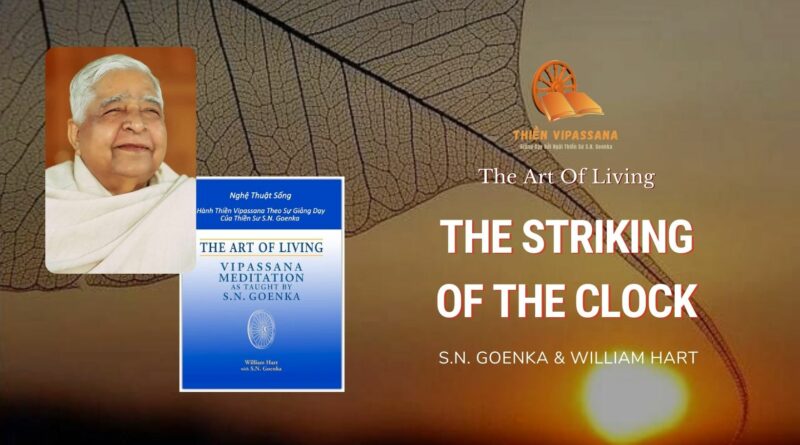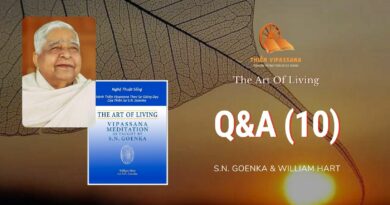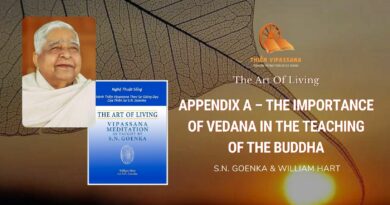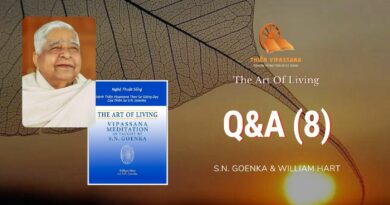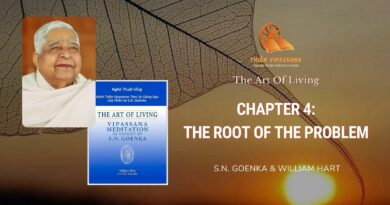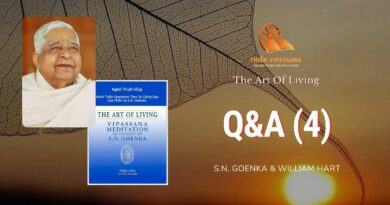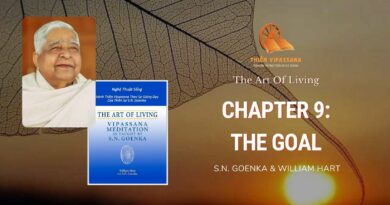The Striking of the Clock
I feel very fortunate that I was born in Burma, the land of Dhamma, where this wonderful technique was preserved through the centuries in its original form. About one hundred years ago my grandfather came from India and settled there, and so I was born in that country. And I feel very fortunate that I was born into a family of businessmen, and that from my teens I started working to gain money. Amassing money was my chief purpose in life. I am fortunate that from an early age I succeeded in earning a lot of money. If I had not myself known the life of riches, I would not have had the personal experience of the hollowness of such an existence. And had I not experienced this, some thought might always have lingered in a corner of my mind that true happiness lies in wealth. When people become rich, they are given special status and high positions in society. They become officers of many different organizations. From my early twenties I began this madness of seeking social prestige. And naturally all these tensions in my life gave rise to a psychosomatic disease, severe migraine headaches. Every fortnight I suffered an attack of this disease, for which there was no cure. I feel very fortunate that I developed this disease.
Even the best doctors in Burma could not cure my sickness. The only treatment that they had to offer was an injection of morphine to relieve an attack. Every fortnight I required an injection of morphine, and then I faced its after-effects: nausea, vomiting, misery.
After a few years of this affliction the doctors began to warn me, “Now you are taking morphine to relieve the attacks of your disease, but if you continue, soon you will become addicted to morphine, and you will have to take it every day.” I was shocked at the prospect; life would be horrible. The doctors advised, “You often travel abroad on business; for once make a trip for the sake of your health. We have no cure for your disease, and neither, we know, have doctors in other countries. But perhaps they have some other pain-killer to relieve your attacks, which would free you from the danger of morphine dependence.” Heeding their advice I travelled to Switzerland, Germany, England, America, and Japan. I was treated by the best doctors of these countries. And I am very fortunate that all of them failed. I returned home worse than when I had left.
After my return from this unsuccessful trip, a kind friend came and suggested to me, “Why not try one of these ten-day courses in Vipassana meditation? They are conducted by U Ba Khin, a very saintly man, a government officer, a family man like yourself. To me it seems that the basis of your disease is actually mental, and here is a technique that is said to free the mind of tensions. Perhaps by practising it you can cure yourself of the disease.” Having failed everywhere else I decided at least to go to meet this teacher of meditation. After all, I had nothing to lose.
I went to his meditation centre and talked with this extraordinary man. Deeply impressed by the calm and peaceful atmosphere of the place and by his own peaceful presence, I said, “Sir, I want to join one of your courses. Will you please accept me?”
“Certainly, this technique is for one and all. You are welcome to join a course.”
I continued, “For a number of years I have suffered from an incurable disease, severe migraine headaches. I hope that by this technique I may be cured of the disease.”
“No,” he suddenly said, “don’t come to me. You may not join a course.” I could not understand how I had offended him; but then with compassion he explained, “The purpose of Dhamma is not to cure physical diseases. If that is what you seek, you had better go to a hospital. The purpose of Dhamma is to cure all the miseries of life. This disease of yours is really a very minor part of your suffering. It will pass away, but only as a by-product in the process of mental purification. If you make the by-product your primary goal, then you devalue Dhamma. Come not for physical cures, but to liberate the mind.”
He had convinced me. “Yes, sir,” I said, “now I understand. I shall come only for the purification of my mind. Whether or not my disease may be cured, I should like to experience the peace that I see here.” And giving him my promise, I returned home.
But still I postponed joining a course. Being born in a staunch, conservative Hindu family, from my childhood I had learned to recite the verse, “Better to die in your own religion, your own
dharma*; never go to another religion.” I said to myself, “Look, this is another religion, Buddhism. And these people are atheists, they don’t believe in God or in the existence of a soul!” (As if simply believing in God or in the soul will solve all our problems!) “If I become an atheist, then what will happen to me? Oh no, I had better die in my own religion, I will never go near them.”
For months I hesitated in this way. But I am very fortunate that at last I decided to give this technique a try, to see what would happen. I joined the next course and passed through the ten days. I am very fortunate that I benefited greatly. Now I could understand one’s own dharma, one’s own path, and the dharma of others. The dharma of human beings is one’s own dharma. Only a human being has the ability to observe himself in order to come out of suffering. No lower creature has this faculty. Observing the reality within oneself is the dharma of human beings. If we do not make use of this ability, then we live the life of lower beings, we waste our lives, which is certainly dangerous.
I had always considered myself to be a very religious person. After all, I performed all the necessary religious duties, I followed the rules of morality, and I gave a lot to charity. And if I was not in fact a religious person, then why had I been made the head of so many religious organizations? Certainly, I thought, I must be very religious. But no matter how much charity or service I had given, no matter how careful I had been of my speech and actions, still when I started observing the dark chamber of the mind within, I found it to be full of snakes and scorpions and centipedes, because of which I had had to endure so much suffering. Now, as the impurities were gradually eradicated, I began to enjoy real peace. I realized how fortunate I was to receive this wonderful technique, the jewel of the Dhamma.
For fourteen years I was very fortunate to be able to practise this technique in Burma under the close guidance of my teacher.Of course I fulfilled all my worldly responsibilities as a family man, and at the same time, every morning and evening, I continued
There is a play here on the various meanings of the word dhamma, or dharma in Sanskrit and modern Hindi. In India today, the word is given a narrow, sectarian meaning, which is here contrasted with its much wider ancient meaning of “nature.” meditating, every weekend I went to the center of my teacher, and every year I undertook a retreat of ten days or longer.
In early 1969 I had to make a trip to India. My parents had gone there a few years earlier and my mother had developed a nervous disease which I knew could be cured by the practice of Vipassana. But there was no one in India who could teach her. The technique of Vipassana had long been lost in that country, the land of its origin. Even the name had been forgotten. I am grateful to the government of Burma for allowing me to go to India; in those days they did not commonly permit their citizens to travel abroad. I am grateful to the government of India for allowing me to come to their country. In July of 1969, the first course was held in Bombay, in which my parents and twelve others participated. I am fortunate that I was able to serve my parents. By teaching them Dhamma I was able to repay my deep debt of gratitude to them.
Having fulfilled my purpose in coming to India, I was ready to return home to Burma. But I found that those who had participated in the course started pressing me to give another, and another. They wanted courses for their fathers, mothers, wives, husbands, children, and friends. So then the second course was held, and the third, and the fourth, and in this way the teaching of Dhamma began to spread.
In 1971, while I was giving a course in Bodh Gaya, I received a cable from Rangoon announcing that my teacher had passed away. Of course the news was shocking, being completely unexpected, and certainly it was very saddening. But with the help of the Dhamma he had given me, my mind remained balanced.
Now I had to decide how to pay back my debt of gratitude to this saintly person, Sayagyi U Ba Khin. My parents had given me birth as a human being, but one still enclosed in the shell of ignorance. It was only with the help of this wonderful person that I was able to break the shell, to discover truth by observing the reality within. And not only that, but for fourteen years he had strengthened and nurtured me in Dhamma. How could I repay the debt of gratitude to my Dhamma father? The only way that I could see was to practise what he had taught, to live the life of Dhamma; this is the proper way to honor him. And with as much purity of mind, as much love and compassion as I could develop, I resolved to devote the rest of my life to serving others, since this is what he wished me to do.
He often used to refer to the traditional belief in Burma that twenty five centuries after the time of the Buddha, the Dhamma would return to the country of its origin, from there to spread around the world. It was his wish to help this prediction come to pass by going to India and teaching Vipassana meditation there. “Twenty five centuries are over,” he used to say, “the clock of Vipassana has struck!” Unfortunately, political conditions in his later years did not allow him to travel abroad. When I received permission to go to India in 1969, he was deeply pleased and told me, “Goenka, you are not going; I am going!”
At first I thought that this prediction was merely a sectarian belief. After all, why should something special happen after twenty five centuries if it could not happen sooner? But when I came to India I was amazed to find that, although I did not know even one hundred people in that vast country, thousands started coming to courses, from every background, from every religion, from every community. Not only Indians, but thousands started coming from many different countries.
It became clear that nothing happens without a cause. No one comes to a course accidentally. Some perhaps have performed a wholesome act in the past, as a result of which they now have the opportunity to receive the seed of Dhamma. Others have already received the seed, and now they have come to help it grow. Whether you have come to get the seed or to develop the seed that you already have, keep growing in Dhamma for your own good, for your own benefit, for your own liberation, and you will find how it starts helping others too. Dhamma is beneficial for one and all.
May suffering people everywhere find this path of peace. May they all be released from their misery, their shackles, their bondage. May they free their minds of all defilements, all impurities.
My all beings throughout the universe be happy.
May all beings be peaceful.
May all beings be liberated.
Bài viết này được trích từ cuốn sách The Art Of Living – Thiền Sư S.N.Goenka và William Hart.

